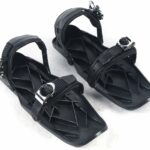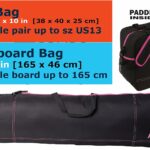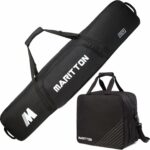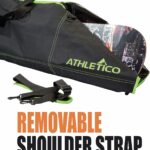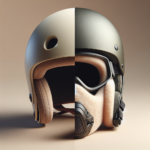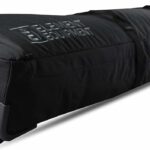If you’re wondering whether a helmet is really an essential piece of equipment when you’re skiing, our opinion is yes, absolutely.
Your safety should be your number one priority no matter what scenario you are in, and you should do everything in your power to ensure you are as safe as possible at all times.

Read on to find out why helmets are so important, and why they’re worth buying and wearing.
What Are The Features Of A Ski Helmet?
Ski helmets are made out of sturdy and lightweight materials, and they are designed with the combination of cold weather and the sporty nature of skiing in mind.
This means that they keep your head well-insulated while also allowing heat to escape when it needs to. Many models of ski helmets have air vents that can be opened and closed as required.
They are typically lined with a moisture-wicking material to help remove sweat, and the linings in many models are removable for washing and customization.
You can get liners with varying degrees of padding to improve the comfort and warmth of the helmet to your tastes and the current weather conditions.
Ski helmets have a sturdy outer shell that can be made from materials like polycarbonate plastic, fiberglass, and carbon fiber.
These are all lightweight materials that are good at absorbing impact, and help to protect the core of the helmet.
The core is the most important part of the shock absorbency of a helmet, it is typically a padded liner made out of expanded polystyrene.
As the core is designed to absorb the force of an impact, it is recommended that you replace your helmet after a particularly hard impact, as the integrity of the polystyrene may have been compromised and therefore won’t absorb shock as effectively as it did before.
Ski helmets are designed to be compatible with ski goggles (see also “What Is VLT In Ski Goggles?“).
Many models of helmets have goggle mounts, which can come in a variety of forms, but serve the same purpose; to hold the goggle strap in place and to keep them secure.
Helmets also have their own straps, which are fitted under your chin to keep it securely in place.
There are also ear covers, which keep the ears warm while still letting sound in.
Some helmets have ear covers that are molded out of plastic and have a padded removable insert, and some ear covers are entirely removable.
How Do Ski Helmets Offer Protection?
Now that we’ve covered what the features of the helmets are, we’ll go into more detail about how these features protect you.
The sturdy outer shell of the helmet protects your head from bumps, scratches, and lacerations.

While the shell may only get some scratches from a scrape with tree branches or hard surfaces, your face would have obtained superficial injuries that may have required stitches.
The outer shell also protects the important inner core of the helmet from these lighter bumps.
The inner core of the helmet absorbs the shock from heavy impacts, which can help protect you from concussions.
When the shockwave works its way through the polystyrene core, it spreads out the force of the shock, and the core absorbs it by being compressed or destroyed.
When your helmet takes a hard hit, it is designed to be able to move and break. If it was fully rigid, the shock would still be passed on through your skull and into your brain.
If you were to get into an accident and see that your helmet ended up cracked and broken, your first thought may be that the helmet was flimsy, didn’t offer protection, and you just got lucky.
However, it is through the damage that the helmet has taken that you know that it has worked effectively, as if the helmet hadn’t absorbed the shock that caused the damage, this same damage would have been absorbed by your head.
It functions similarly to the crumple zone of a car, where it is designed with the intention of breaking as this is what protects you.
Because of the intricacies of how the shock absorption works, it is vital that you get your helmet professionally fitted, especially in the case of children.
If the helmet is not a correct fit, the shock absorbency will be diminished. This is why you are always advised against getting children’s helmets with the intention of them “growing into it.”
All helmets will have some degree of adjustability to ensure your comfort and to adapt to the shape and size of your head. These adjustments are how you can alter the fit of the helmet, rather than wearing the incorrect size.
Helmets also protect you by keeping you warm, dry, but well ventilated. They protect your ears, which are at particularly high risk of damage from the cold.
Helmets also hold your goggles, another vital piece of kit, in place.
Do Ski Helmets Really Work?
The amount of people who wear helmets has risen dramatically since the 90s, and high profile stories about Michael Schumacher’s life-changing injuries and Natasha Richardson’s death spurred many to take their safety more seriously.
The amount of lacerations and minor head injuries have reduced significantly along with the uptake in helmets.
There are still fatalities from particularly violent accidents and injuries, as helmets can only protect you from so much.
Some may use this as a justification for not wearing a helmet at all, but you wouldn’t discard your seatbelt and airbags in a car just because bad accidents can still be fatal.
Even if you are a skilled skier, you cannot guarantee that there won’t be a freak accident in your future.
Other less skilled skiers also pose a collision risk to you – there are too many variables to be able to definitively say that you are skilled enough to not need a helmet.
Final Thoughts
Overall, we strongly recommend using a helmet while skiing, even if it isn’t mandatory where you are. Modern helmets are designed to be lightweight and comfortable, so it’s not as though they are particularly cumbersome.
The benefits they offer far outweigh the dangers of not wearing a helmet at all, so always keep your safety in mind.
Children should always be equipped with the correct safety gear in any sport, but it is often mandatory in skiing schools and resorts for children to have full protection.
We hope you’ve found this article useful – stay safe, and happy skiing!
- How to Choose a Skim Board - September 10, 2023
- is Skim Boarding Hard? - February 8, 2023
- How To Wax a skim board - February 8, 2023

